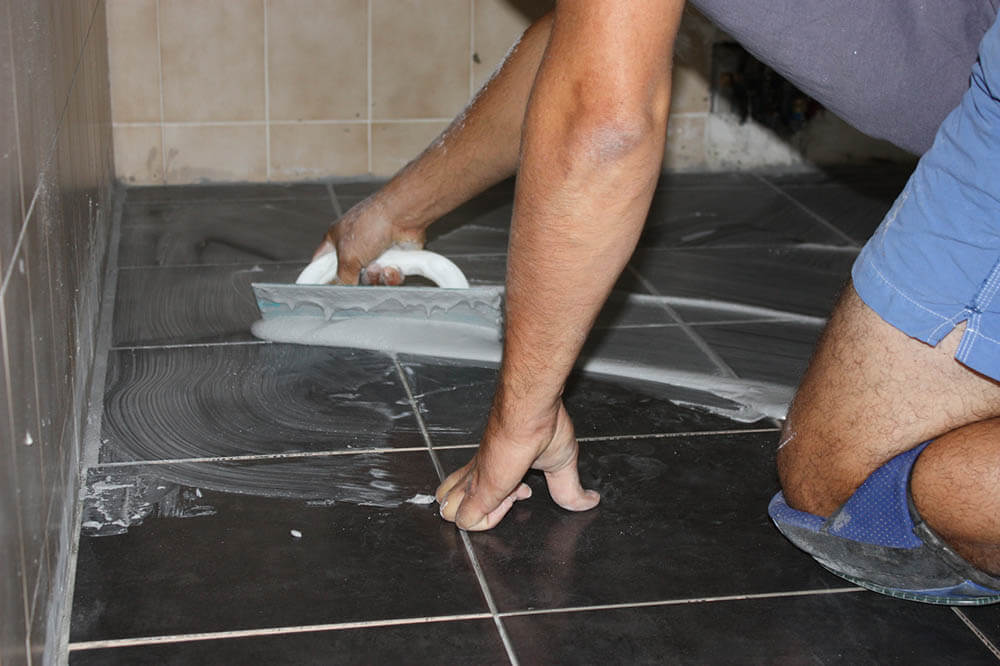Ever stared at your tired, outdated tile floors and dreamed of a sleek, modern makeover? Epoxy flooring has risen in popularity as a durable, stylish, and easy-to-maintain solution. But, can you simply pour that glorious epoxy over your existing tiles and call it a day? Well, the answer isn’t quite as straightforward as it might seem.

Image: www.maisonentravaux.fr
This guide dives into the world of epoxy flooring over tile, exploring the complexities, considerations, and best practices. We’ll demystify the process, equip you with the knowledge to make informed decisions, and empower you to transform your floors with confidence.
Understanding the Basics: Epoxy Flooring and Its Appeal
Epoxy flooring, essentially a resin-based, high-performance coating, boasts incredible durability, seamless aesthetics, and remarkable resistance to stains, chemicals, and abrasion. Its versatility makes it ideal for both residential and commercial spaces, from kitchens and bathrooms to garages and industrial settings.
However, applying epoxy over tile is a unique challenge demanding careful planning and execution. It’s not a simple paint-over situation. We’ll explore the key factors determining the feasibility and success of this project.
Unveiling the Challenges: Why Epoxy Over Tile Isn’t Always Easy
While the idea of a quick floor makeover might be tempting, laying epoxy over tile presents some hurdles:
1. Adhesion Issues: Epoxy’s strength relies on bonding to a properly prepared surface. Tile, with its glazed surface, offers poor adhesion unless treated. The epoxy might peel or crack without a solid bond.
2. Surface Texture: Tile surfaces are smooth, potentially leading to a slippery epoxy finish. This can be hazardous, especially in areas with moisture or foot traffic.
3. Unevenness: Tiles often have grout lines, creating an uneven surface. These imperfections can show through the epoxy, compromising the visual appeal.
Factors Determining Feasibility: Asking the Right Questions
Before jumping into your epoxy project, ask yourself these crucial questions to assess the viability:
1. Tile Condition: Is your tile in good condition? Damaged, cracked, or loose tiles need attention before epoxy application.
2. Tile Type: Smooth, glazed tiles offer poor adhesion compared to textured tiles. Unglazed tiles are generally preferred.
3. Grout Condition: Grout should be in good condition, free from cracks and loose mortar. It needs to be cleaned thoroughly before epoxy application.

Image: epoxyflooringco.com.au
The Preparation Process: The Key to Success
If you’ve determined epoxy over tile is a viable option, a meticulous preparation process is essential for a long-lasting and beautiful outcome:
1. Cleaning: The Foundation for Adhesion
-
Remove all debris, wax, and sealant: Thoroughly clean the tile surface using a degreaser. Ensure there are no residues that can interfere with the epoxy’s bond.
-
Clean grout lines: Use a brush or grout cleaner to remove dirt, grime, and mold. This step is vital for a seamless final finish.
2. Sanding: Creating a Grip for the Epoxy
-
Sand the tile surface: Use a coarse-grit sandpaper to roughen up the surface, creating a texture for the epoxy to bond to. This is especially crucial for smooth, glazed tiles.
-
Focus on grout lines: Sand the grout lines gently to ensure a smooth transition between tiles and epoxy.
3. Priming: The Essential Bonding Agent
-
Apply a primer specifically formulated for tile: This creates a strong foundation for the epoxy to adhere to, preventing peeling and cracking.
-
Follow manufacturer’s instructions: Each primer has specific drying times and application techniques. Be sure to follow these guidelines closely.
The Epoxy Application: Achieving a Professional Finish
With the surface prepared, you’re ready for the epoxy application:
1. Choose the Right Epoxy: Select an epoxy specifically designed for tile floors. Ensure it has good adhesion, durability, and the desired level of shine.
2. Read the Instructions: Pay close attention to the manufacturer’s instructions for mixing, application, and curing times. Follow these guidelines carefully for optimal results.
3. Apply the Epoxy:
-
Start with a smooth and even coat: Use a roller or squeegee to apply a thin, even layer of epoxy over the entire tile surface.
-
Work quickly and efficiently: Epoxy starts to cure quickly, so work in sections to avoid uneven application.
-
Address air bubbles: Use a roller or squeegee to gently remove any air bubbles that may appear.
4. Curing Time: Allow the epoxy to cure fully according to the manufacturer’s specifications. This typically involves avoiding any heavy foot traffic or water exposure.
Expert Advice: Maximizing Your Epoxy Flooring Over Tile
1. Consult with a Professional: If you’re unsure about the process or have a complex project, consider hiring a professional epoxy flooring installer. They possess the expertise to ensure a successful outcome.
2. Test a Small Area: Apply a small amount of epoxy on a discreet area first to test the adhesion. If the epoxy peels or cracks, it’s a clear indication that the surface requires further preparation.
3. Consider a Sealer: Applying a sealant to your epoxy floor after curing can enhance its durability and make it easier to maintain.
Can You Put Epoxy Flooring Over Tile
Wrapping Up: The Transformative Power of Epoxy Flooring
Ready to ditch your dated tile floors for a sleek, modern look? Epoxy flooring over tile can be a transformative solution, but the key lies in careful preparation and the right approach. This comprehensive guide has clarified the complexities, empowered you to make informed decisions, and provided the know-how for a successful transformation. Remember, for a truly professional finish, consult with a flooring expert. Embrace the potential of epoxy flooring and create a space that reflects your personality and lifestyle.






